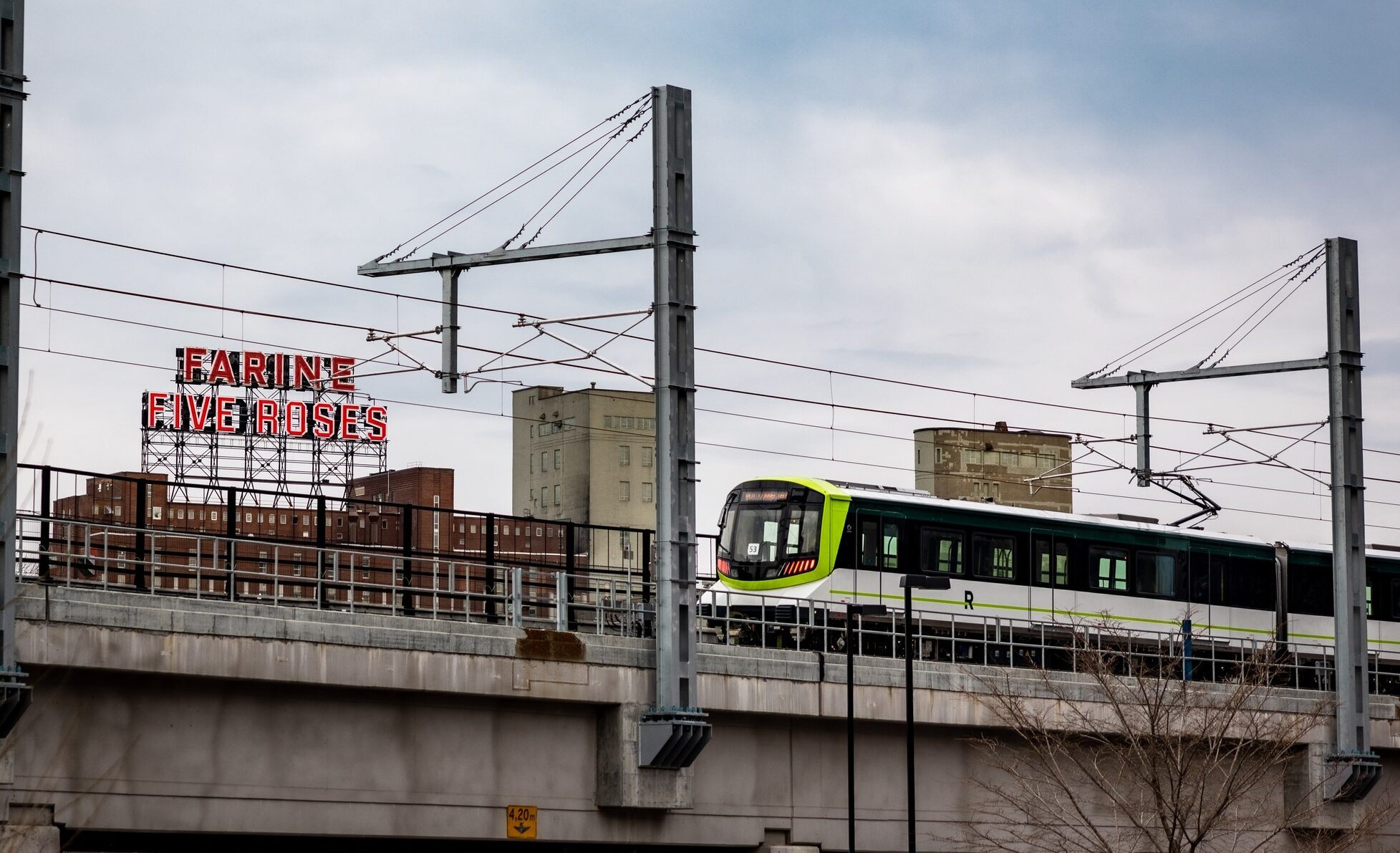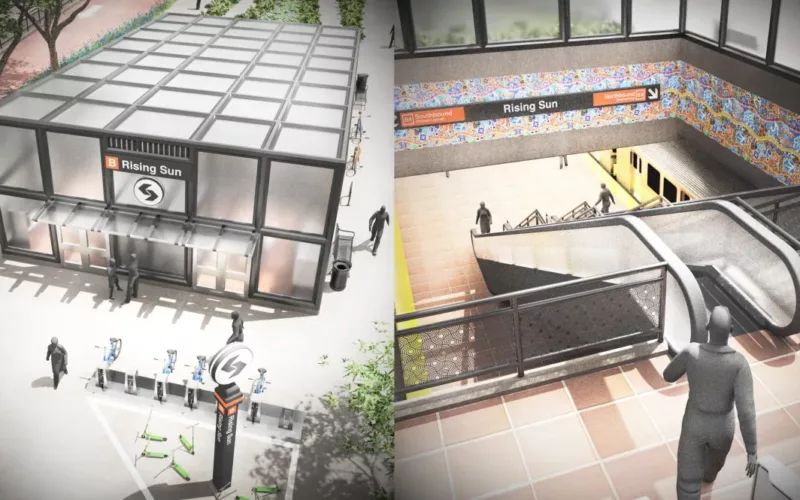
This post was written by Eric Goldwyn.
Every week there’s a new story about an American transit project that is behind schedule, over budget, or “paused”. Why is it so difficult to build subway and light rail projects in America? Our research team at the Transit Costs Project at NYU’s Marron Institute has identified specific issues like governance, physical structure, and procurement as central issues that drive costs and add delay. Streamlining and even eliminating these barriers is all the more urgent as the federal government has increased transit funding. If costs continue to rise faster than funding increases, we will squander the opportunity to transform our transportation network and make transit a viable option for more people.
Montreal’s Réseau express métropolitain (REM) stands out as a recent North American project that has begun to address some of the challenges that have foiled so many others. Earlier this summer, REM launched the first leg of its automated light metro service connecting Greater Montreal to its Central Station downtown. REM is projected to eventually move 160,000-170,000 riders per day via 26 stations along 41 miles of track. Total cost estimates for the project have gone from C$6.3 billion to C$7.95 billion. This 26% increase is notable, but even at C$191 million per mile, the number is well below global averages and significantly less than US projects that routinely eclipse a billion dollars a mile. What is REM getting right that other projects aren’t?
Governance
REM’s success stems from its ability to align Phillippe Couillard, Quebec’s premier, and Denis Coderre, Montreal’s mayor, to ease coordination challenges that stymie US projects. In 2017, Quebec passed a law granting REM expansive authority not usually granted to transit agencies in the United States or Canada. As an example, the law stated that if the project team needed access to a local road for REM construction if the local municipality withheld permits after a final 60-day review period, REM could proceed with construction without providing any compensation. As one can imagine, this controversial law incentivized local agencies to work with REM and find common ground rather than slow down the project.
Domestic transit agencies routinely struggle to finalize interlocal and third party agreements with municipalities, utilities, freight railroads, and property owners, which adds delay and costs. In Dallas, DART has struggled to get the City of Dallas to approve permits for its Silver Line project, even though it has an interlocal agreement with the city that says Dallas will issue permits within 10 days. DART CEO, Nadine Lee went so far as to shame the City of Dallas in the press and argue that these delays cost the agency $150,000 a day. In one example, she pointed to a permit that took 290 days to execute, which means it added $42 million to the project’s budget.
Physical Structures
As early as 2018, REM released standardized station designs that vary based on whether the station is at grade, elevated, or underground. Thus, the stations fit into a unified network of 26 stations rather than each station striving to achieve the architectural sublime. By standardizing station designs, the design work is minimized because once the design is set, it only needs small adjustments when siting a new station. Standardized materials allow for bulk purchasing for all 26 stations. Finally, any challenges or lessons learned during construction can be applied to future stations, which helps speed up construction timelines.
What is a transit station? Is it a utilitarian box or shelter that provides easy access to trains and buses? Or is it an opportunity to build a unique architectural object that responds to every possible neighborhood need? When transit projects prioritize the latter question, station sizes expand to include neighborhood amenities and unique designs, like New York’s ~$4 billion Oculus. When we interviewed designers working on the first iteration of the MBTA’s Green Line Extension, a project that was redesigned to cut costs with more standardized stations, we were told that in the original plan, each station had its own iconic headhouse. Bespoke designs add costs and slow down construction because each project is unique, which limits the lessons learned that can be applied to future stages of the project. Bent Flyvbjerg and Dan Gardner’s recent book How to Get Big Things Done, argues that in order to build megaprojects on time and on budget, they must have legos, modular pieces, such as stations, that can be scaled up and down so that they can be rapidly deployed. Additionally, lego construction informs and improves with experience because future legos benefit from previous experiences. This is a powerful idea that REM embraced.
Building new tunnels can be one of the costliest aspects of transit construction projects, and our view is that projects should attempt to reuse existing infrastructure whenever possible. Embracing that philosophy, REM chose to retrofit the old 3-mile Mont-Royal tunnel instead of building a new one. An unexpected cache of leftover explosives was inadvertently detonated during construction, which added $C350 million ($255 million US dollars) and delayed the project by 18 months. Despite this unexpected cost, the total was still likely cheaper than building a new tunnel. Moreover, the tunnel is no longer a drag on capacity and can now handle trains every 90 seconds. New York’s Interborough Express, a project that is still in the planning phase, is another project that is attempting to squeeze more transit out of existing infrastructure by thinking creatively about what has already been built.
Procurement
Transit agencies have experimented with alternative procurement methods to shift risk, speed delivery, and reduce costs. In general, we argue that the traditional design bid build is the best form of procurement for transit projects because these projects tend to have unique challenges that make them riskier, i.e. more expensive, for a private entity to bear. We caveat this with a broader point, any type of procurement method can work so long as it is matched with vision, leadership, and the ability to manage third-party and interagency issues quickly. REM is a public-private partnership that operates outside the bounds of traditional design bid build. Rather than a public agency procuring a design, and then tendering construction contracts based on those designs, CDPQ Infra took on REM’s planning, design, and construction with the guarantee of a flat distance-based fee for each passenger. Maryland’s Purple Line, in contrast, is a domestic PPP that has struggled with third-party and interagency coordination from the outset. Freight railroads, leadership changes in Annapolis, shifting environmental regulations, and a self-dealing judge have all made it difficult for the concessionaire to deliver the project on time and on budget.
There is hope
2023 has been brutal for capital expansion projects in the U.S. In addition to ridership uncertainty due to COVID and global supply chain instability, FTA earlier this year requested that projects seeking federal funding add more contingency to project budgets. This took already very expensive projects that were difficult to fund and made some of them impossible to fund. From Austin to Atlanta agencies scaled back their visions as they adapted to soaring costs. REM’s debut in August could provide a potential model for projects that are still on the drawing board, like Philadelphia’s Roosevelt Boulevard Subway.
There are tangible lessons from REM that can be applied to projects in the U.S.: First, figure out governance. If agencies don’t have the power to force decisions on permits within a timely manner, it is inevitable that transit projects will encounter delays and greater costs. Second, standardize everything. Transit should be fast and frequent. Stations aren’t underground cathedrals where we go to commune with the gods of public transport. They are well-lit boxes where, if we are lucky, we will stand or sit for two minutes before getting onto a train. Finally, instead of arguing about alternative procurement, such as Design-Build versus Progressive Design Build versus Construction Manager/General Contractor versus whatever other arrangements someone dreams up, let’s assemble experienced teams that have a track record of delivering projects on time and on budget.
 On the Brink: Will WMATA’s Progress Be Erased by 2024?
On the Brink: Will WMATA’s Progress Be Erased by 2024?
The experience of being a WMATA rider has substantially improved over the last 18 months, thanks to changes the agency has made like adding off-peak service and simplifying fares. Things are about to get even better with the launch of all-door boarding later this fall, overnight bus service on some lines starting in December, and an ambitious plan to redesign the Metrobus network. But all of this could go away by July 1, 2024.
Read More To Achieve Justice and Climate Outcomes, Fund These Transit Capital Projects
To Achieve Justice and Climate Outcomes, Fund These Transit Capital Projects
Transit advocates, organizers, and riders are calling on local and state agencies along with the USDOT to advance projects designed to improve the mobility of Black and Brown individuals at a time when there is unprecedented funding and an equitable framework to transform transportation infrastructure, support the climate, and right historic injustices.
Read More